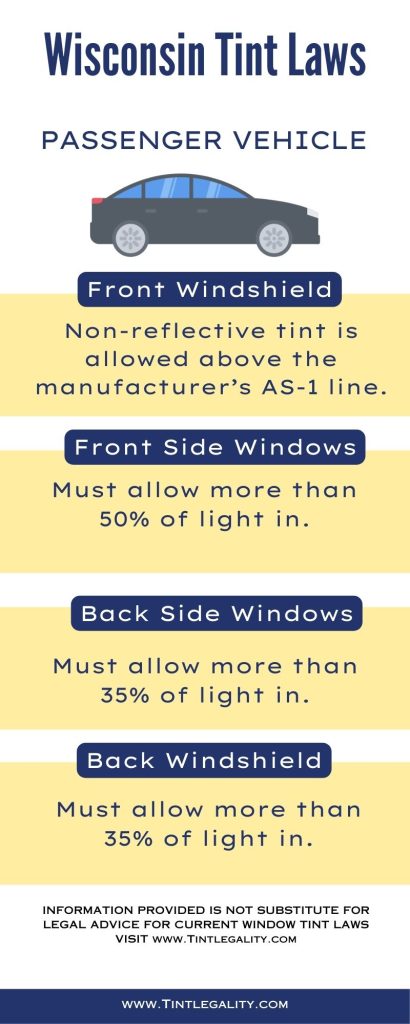Wisconsin tint laws were enacted in 1996, aiming to ensure the safety of the state’s motorists.
These laws regulate how dark or reflective the tint on vehicle windows can be.
Regulations Regarding Window Tint in Wisconsin
Wisconsin law stipulates different limits for tint darkness based on the type of vehicle and the specific window in question.
The percentage of light allowed through your window film and glass in Wisconsin is very specific and different for sedan cars and SUVs and vans.
| Car Window Part | Legal Limit for Tint Darkness |
|---|---|
| Windshield | Non-reflective tint allowed above the manufacturer’s AS-1 line |
| Front Side Windows | Must allow more than 50% of light in |
| Back Side Windows | Must allow more than 35% of light in |
| Rear Window | Must allow more than 35% of light in |
| Reflection | Tint cannot be reflective |
| Medical Exemptions | Exemptions available for certain medical conditions |
| Color Restrictions | No specific color restrictions |
| Side Mirrors | Required if rear window is tinted |
Windshield
For windshields, non-reflective tint is allowed along the top of the windshield above the manufacturer’s AS-1 line.
This keeps the driver’s view relatively clear while still offering some protection from the sun.
Front Side Windows
The front side windows of any vehicle, be it a sedan, SUV, or van, must allow more than 50% of light in.
This regulation ensures that drivers have a clear view of their surroundings, enhancing safety on Wisconsin’s roads.
Back Side Windows
For the back side windows, the law allows a little more leniency.
The tint must allow more than 35% of light in.
This law applies to all vehicle types, including sedans, SUVs, and vans.
Rear Window
Just like the back side windows, the rear window must allow more than 35% of light in.
This ensures that drivers can adequately see vehicles behind them through the rear-view mirror.


Additional Regulations
In addition to the rules above, Wisconsin has several other regulations that car owners need to keep in mind when applying window tint.
Reflection
In Wisconsin, window tints can reflect incoming light and reduce glare and heat.\
However, the tinting film used must not be reflective. This regulation aims to prevent potential vision impairment for other drivers caused by the glare from reflective tints.
Medical Exemptions
Wisconsin law acknowledges that some drivers may have medical conditions that require darker window tints.
Therefore, it does provide medical exemptions for darker tint.
Color Restrictions
Interestingly, unlike some states, Wisconsin does not restrict tint colors.
Thus, motorists in Wisconsin have the freedom to choose any tint color they prefer, providing it complies with the light transmission requirements.
Side Mirrors
If a vehicle’s rear window is tinted, dual side mirrors are required in the state.
This rule ensures that drivers have a good view of the road, even if the rear window tint exceeds 60% VLT.
Exceptions to Legal Limits
There is a 3% variance allowed in the legal limits set by the state.
This acknowledges that there may be slight inconsistencies in the manufacturing process of the tint.
Penalties for Breaking the Law
Breaking the Wisconsin tint laws comes with a series of penalties.
It’s essential for every motorist to understand what they could face if they don’t comply.
Fines
The fine structure in Wisconsin for tint law violations is graduated:
- First Conviction: A fine of up to $175.30.
- Second Conviction: A fine of up to $200.50 if within three years of the first conviction.
- Third Conviction: A fine of up to $263.50 if within three years of the first conviction.
Other Penalties
In addition to the fines, non-compliance with Wisconsin’s window tint laws may lead to the issuance of demerit points against your driver’s license.
Also, law enforcement officers have the right to stop and inspect any vehicle they believe may not be in compliance with the law.
The responsibility lies with the vehicle owner to ensure their window tint meets Wisconsin’s standards.
It’s always recommended to double-check the tint specifications with local DMV or law enforcement authorities before application.